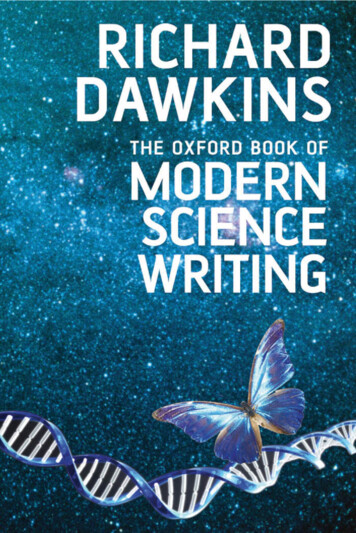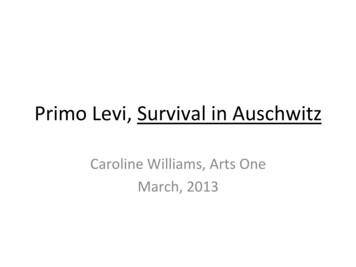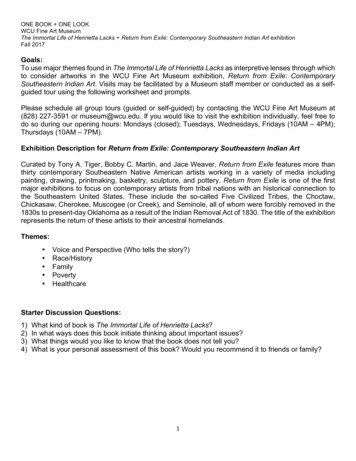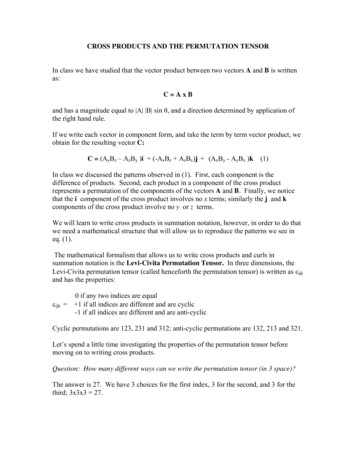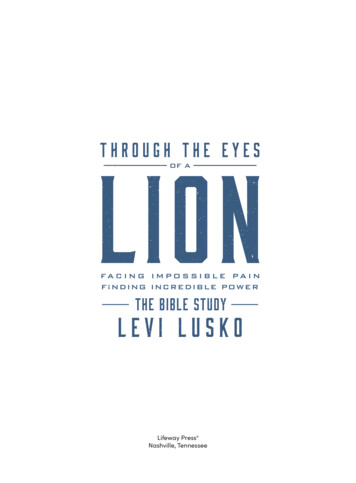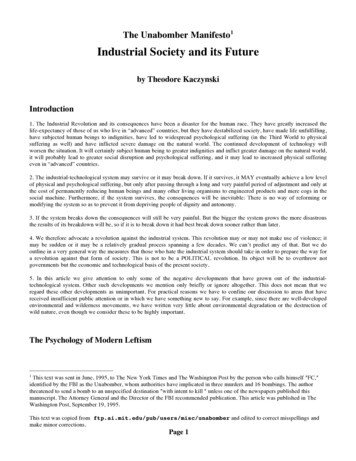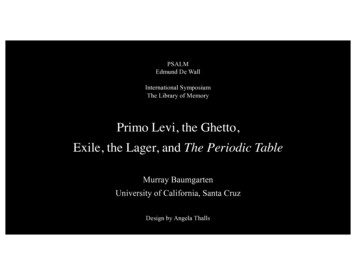
Transcription
PSALMEdmund De WallInternational SymposiumThe Library of MemoryPrimo Levi, the Ghetto,Exile, the Lager, and The Periodic TableMurray BaumgartenUniversity of California, Santa CruzDesign by Angela Thalls
Reading Primo Levi’s The Periodic Table
1. An Italian Jew Deploys a Yiddish Proverbto Reframe a Western Cultural Stereotype
As he explores the continuing impact of personal andcommunal trauma in the post-war era, Primo Levi asksif it is possible to undo the stigma of the European ageold stereotyping of the Ghetto, which the murderousNazi Lager multiplied and amplified horrendously intoa cultural trope that branded the Jews.
Can words undo an age-old stereotype and viciousmodern Holocaust trauma? Or rewrite the library ofbitter memories that had been inscribed on him and hispeople?Can words restore the Jews – the people defined asaliens –to full humanity and citizenship among thepeoples and nations of Europe?
If you don’t know Yiddish you aren’t Jewish, Leviwas told in Auschwitz.Nevertheless, he begins The Periodic Table with aYiddish Proverb: he had learned how importantYiddish – the exilic language of the Jews of EasternEurope – is for the history of Jewish culture
He learned Yiddish only after his return to Turin. Heneeded Yiddish to interview the surivivorsstreaming through Italy on their way to Israel wherethey would participate in the post-war struggle forIsraeli independence.
The epigraph of The Periodic Table is a Yiddish proverb:Iberkumene tsores iz gut tzu dertseylinAnd Primo Levi immediately provides an Italian translation:É bello raccontare i guai passatiIn English translation:Troubles overcome are good to tell
This is an oral account: you share in theunderstanding of what it means to tell raccontarethe story. The Yiddish proverb is in the activepresent tense. Let us call it a narrative imperative.In this language of every-day life the Jews inExile fashioned a nimble idiom.
In Levi’s phrasing we hear a definition ofJewish literature, which as Ruth Wisse hasreminded us, is an oral conversation –“Two Jews Talking.”The Ancient Mariner, cherished by Primo Levi,talks and tells his story to anyone who willlisten, and tells and retells his story.
Continuously open to Hebrew, religious,Biblical and intellectual dialectic, Yiddishwas the language that helped these Jewssurvive as a people in Exile.It was the vehicle that made it possible toimagine how they might answer the call ofPsalm 137 – and even in a foreign land, atleast hear the Lord's song.
I am reminded of Giuseppe Verdi's responsein 1841, when he wrote “Va Pensiero,” thechorus of the Hebrew slaves in Nabucco, tothe Italian libretto by Temistocle Solera.It speaks of the lost homeland and the“membranza si cara – memories so dear,” –and still has a contemporary resonance inItaly today.
For me it also brings to mind that even todayin speaking Yiddish, Jews reference theirhistoric European homelessness.This language of Jewish Exile yet offers aglimpse of how we might transform ancienthomelessness into a modern Diasporic home.
In naming his installation, “Psalm,”Edmund De Waal situates it in the long storyof Exile; and as the Library of Memoryechoes the Psalmist's call, it makes roomfor Primo Levi's writing.
Production of Verdi’s Nabucco – “Va, pensiero” – https://www.youtube.com/watch?v rUUVnJjkcAM
The Yiddish epigraph of The Periodic Table highlightsthe process of telling.It is in the telling that the troubles tzores are nowovercome. Their telling is continuous – an ongoingactivity like study of Jewish texts, which is unending .The Italian phrasing like the Yiddish proverb isemphatically in the present tense of the telling.
Telling and ReTelling the Shoah StoriesHe told me his story, and today I have forgotten it, but itwas certainly a sorrowful, cruel and moving story,because so are all our stories, hundreds of thousands ofstories, all different and all full of a tragic, disturbingnecessity. We tell them to each other in the evening, andthey take place in Norway, Italy, Algeria, the Ukraine,and are simple and incomprehensible like the stories inthe Bible. But are they not themselves stories of a newBible?
The Learning Curve of The Periodic Table2. Ancestors and Humiliation in theComing of Age Story
The Periodic Table begins with the less than warmwelcome granted the Jews in Piedmont.Jews introduced the technology of making silk insouthern Piedmont; they would not get beyond thestatus of an extremely tiny minority, never much lovedor much hated. A wall of suspicion, of undefinedhostility and mockery, must have kept them substantiallyseparated from the rest of the population, even severaldecades after the emancipation of 1848.
On coming out of school my father’scontemporaries used to mock him withoutmalice, greeting him with the corner of theirjackets gathered in their fists to resemble adonkey’s ear and chanting, “Pig’s ear,donkey’s ear, give ‘em to the Jew that’s here.”
The allusion to the ear is arbitrary, and the gesture wasoriginally the sacrilegious parody of the greeting thatpious Jews would exchange in synagogue when calledup to read the Torah, showing each other the hem of theprayer-shawl whose tassels, minutely prescribed byritual as to number, length and form, are replete withmystical and religious significance.
The passage telescopes his father’s experience and hiscommunity’s, punctuating it with Levi’s experience in theLager.I remember here in passing, that the vilification of theprayer shawl is as old as anti-Semitism – from thoseshawls, taken from deportees, the SS would makeunderwear which was distributed to the Jews imprisonedin the Lager.How to understand that image – the symbol of thehumiliation of the Ghetto and the Lager? These phrasesrivet the reader into the world that Ghettoization, Fascism,and Nazism made.
For the Ghetto shamed the Jews,and the Lager branded them as subhuman.What strategies could recuperate them?Bring them out of traumatic repetitiveobsession-compulsion? To functioningmanhood, womanhood?
3. Ancestors and Argon
The first chapter, “Argon,” opens with a discussion ofone of “the so-called inert gases in the air we breathe.”The beginning of the second paragraph quickly turnscomparative, leading readers into the realm ofmetaphor.
First Levi characterizes the elements.Like Argon, his ancestors wereso inert, so satisfied with their condition that they donot interfere in any chemical reaction, do not combinewith any other element, and for precisely this reasonhave gone undetected for centuries.
The little that I know about my ancestorspresents many similarities to these gases.These characteristics of Argon, especially itsinertness, define his ancestors. He wonders ifhe too, like Argon, will be inert.
It can hardly be by chance that all the deedsattributed to them, though quite various, havein common a touch of the static, an attitude ofdignified abstention, of voluntary (or accepted)relegation to the margins of the great river oflife. Noble, inert, and rare: their history is quitepoor when compared to that of other illustriousJewish communities in Italy and Europe.
Comparing chemical elements and familyhistory, The Periodic Table crystallizes anunusual combination for metaphor-making.The connections between familial behavior andArgon, one of the most abundant elements ofthe Periodic Table - the stuff of autobiographyand of science respectively- become entangled.The 21 elements, fundamental stuff of modernscience, name the different episodes of thiscoming-of-age story.
4. The Hinge of the Narrative
The eleventh chapter focuses on the Lager.This central hinge of the 21 chapters isentitled "Cerium," named for the flintsPrimo Levi takes from the chemistry labof Buna-Auschwitz
And the flints, which he and his buddy-bunkmateAlberto scrape to fit the black-market cigarettelighters of the Lager, gain them two months ofadditional bread.And then the Soviet soldiers liberate the Lager.
Recall that in the last chapter of his earlier book,If This Is a Man, Levi describes how these liberatedsurvivors work together to find food, to cook it, eat it,rest. It is a moment of respite. we lay in a world of death and phantoms – but inHut 14, there was singing.
Primo Levi and his colleagues in the scenes at theend of If This Is A Man, ''The Story of Ten Days,"evaded the death-vectors of Auschwitz bycollaborating and constituting a cooperative socialworld in opposition to the Hobbesian war of allagainst all of the Nazi Lager.
Now we are on an upward trajectory: After the Lagerchapter, each encounter with matter brings a smalland steadily increasing success. In the chaptersleading up to Cerium, there are a series of smallcatastrophes, now there are successes.Yes, some of the new opportunities have a touch ofthe absurd, including the task of extracting fromchicken shit the alloxan needed to make lipstick.
And then there is the story when two fleeing Germanpilots ask directions as to how to fly to Switzerland.In return they give his friend what they claim isuranium.A small block of metal, about half a cigarette pack insize, actually quite heavy and with an exotic look.
The reflexes of the chemist lead Primo to test it.He discovers it is not uranium but cadmium. Thistime the substitution – unlike his experience in"Potassium" in the first half of the book, does notlead to an explosive mess, just a rueful discussionof how the end of the war has led to fictionalaccounts of heroic exploits.
5. The Carbon Connection
Grounded in first-person telling of the narrator'sexperience as he becomes a chemist and growsinto manhood, Primo Levi reflects on hisunfolding life-experiences.And in the third-person narration the narrativeelicits a series of coming-of-age accounts of ayoung middle-class Italian Jew.
To carbon, the element of life, my firstliterary dream was turned, insistentlydreamed in an hour and a place whenmy life was not worth much, yes, I wantedto tell the story of an atom of carbon.
The retiring chemist canleaf through any treatise and memories rise up and while every element says something tosomeone, and usually something different toeach Carbon is an exception – because itsays everything to everyone.
The Journey of a Carbon Atom
A carbon atom, imprisoned for centuriesin limestone worthy of “the Catholic Hell,”is liberated by a pickaxe. They areintermediaries in the millennial dialoguebetween elements and man.
For the moment of the liberation ofthe carbon atom the present tense ofdescription is suited, rather than thepast tense, which is narration.
Carbon is a singular element: it is the onlyelement that can bind itself in long stable chainswithout a great expense of energy, and for lifeon earth (the only one we know so far) preciselylong chains are required. Therefore, carbon isthe key element of living substance.
We hear Primo speaking to us,as the atom of carbon fliesthree times around the world, until 1960,when it enters the food chain andenters a glass of milk,which Primo drinks.
In his body the chain of which carbon isthe key elemententers the bloodstream, knocks at the doorof a nerve cell, and enters my brain, thebrain of the me who is writing, and the cellin question, and within it the atom inquestion, is in charge of my writing, in agigantic minuscule game which nobodyhas yet described.
This is now the organic chemistry of life:and this atomat this instant, issuing out of a labyrinthinetangle of yeses and nos, makes my hand runalong a certain path on the paper, mark itwith these volutes that are signs: a doublesnap, up and down, between two levels ofenergy, guides this hand of mine to impresson the paper this dot, here, this one.
Tucked away in this account, thereis a subtext -- that of the Jews andmodern civilization. For they havefunctioned as human compatriots ofcarbon, linking chains of culturalDNA, in intricate modes.
In his writing Levi speaks to us –his writing is speaking –the technology that has drivenour modern civilization as wellas our Jewish experience.
Centro Primo Levi New York – /10/levimaschera.jpg
Passerby, I don’t ask you or others for forgiveness,Or for prayers or tears or particular memory.I ask only one thing: that this peace of mine will last,Without new blood, filtering through the clods,Penetrating down to me with its deadly warmth,Waking to new sorrow these bones already now made stone.Primo Levi1745171919–1987
Centro Primo Levi New York – /10/levimaschera.jpg
ResourcesBaumgarten, Murray. “Primo Levi, the Ghetto, Exile, the Lager, and The Periodic Table”(Full presentation) International Symposium, The Library of 1QF3tiDRIQsdztBGnqJxMUdhdrGi?usp sharingRoth, Philip “A Man Saved by His Skills” NY Times Interview with Primo LeviNY Times Book Review, April 12, -saved-by-his-skills.htmlBaumgarten, Murray. ”Small Differences: A reading of 3/shofar.32.1.60?seq 1#page scan tab contentsBosch, Daniel “On Epitaphic Fictions: Primo Levi” The Paris Review. Apr 30, /on-epitaphic-fictions-primo-levi/
The eleventh chapter focuses on the Lager. This central hinge of the 21 chapters is entitled "Cerium," named for the flints Primo Levi takes from the chemistry lab . Asmall block of metal, about half a cigarette pack in size, actually quite heavy and with an exotic look.


